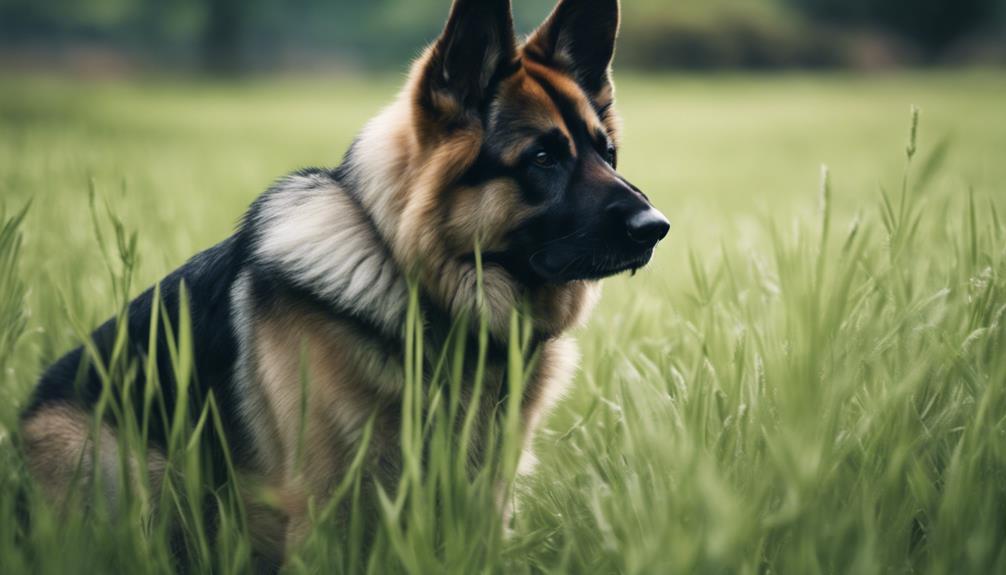🐾 Paw-some Partnership Alert! 🐾
As a pack of German Shepherd enthusiasts at MixGermanShepherd.com, we're always sniffing out the best products for our furry friends. Guess what? When you fetch something from Amazon through our links, we earn a little treat! 🦴
Imagine a world where the striking black and white coat of the Panda German Shepherd stands out in a sea of traditional colors, a breed that captivates with its unique appearance and personality. As you explore the intricacies of this fascinating variation, you will uncover a wealth of information that goes beyond the surface. Discover the secrets behind their captivating looks and delve into the complexities of raising and nurturing these extraordinary companions.
Key Takeaways
- Panda German Shepherds originated from a genetic mutation, showcasing unique color variations.
- Their rarity stems from a specific genetic anomaly, making them a scarce breed.
- Proper care, health monitoring, and genetic testing are crucial for their well-being.
- Early socialization, training, and consistent leadership manage their loyal and protective temperament effectively.
Panda German Shepherd Overview
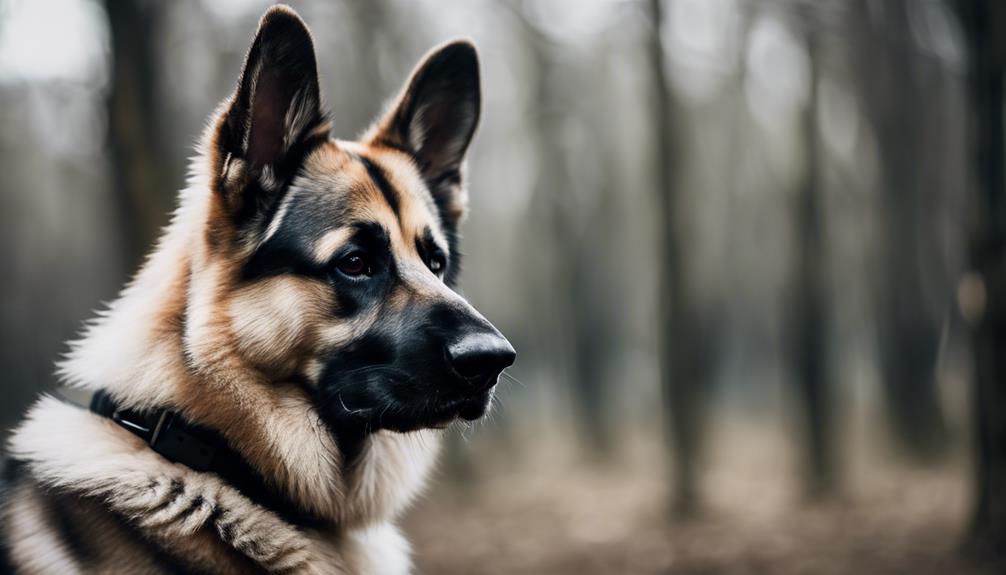
Panda German Shepherd Overview: The Panda German Shepherd, a unique color variation of the German Shepherd breed, displays distinctive white, black, and often tan or red colorations reminiscent of a panda bear, originating in Germany in the late 19th century for specific working purposes. The striking appearance of Panda Shepherds is attributed to a genetic mutation affecting the KIT gene, resulting in symmetrical white markings that distinguish them from traditional German Shepherds.
Breeders carefully select Panda German Shepherds to maintain these unique characteristics through specific breeding practices. Their health and grooming care are crucial to ensuring their well-being, including monitoring for fair hips, normal elbows, and overall health to promote longevity. Regular grooming is essential to maintain the coat's health and appearance, ensuring the distinctive color pattern remains vibrant.
In terms of temperament, Panda German Shepherds are known for their courageous, loyal, and highly trainable nature, mirroring the qualities of their standard German Shepherd counterparts. Active training and socialization are key components in nurturing their skills and ensuring they develop into well-rounded companions. Understanding the needs of Panda Shepherds and providing them with proper care, training, and attention is essential to fostering a strong bond and a fulfilling relationship with these unique and fascinating canine companions.
Origin and History of Panda Shepherds
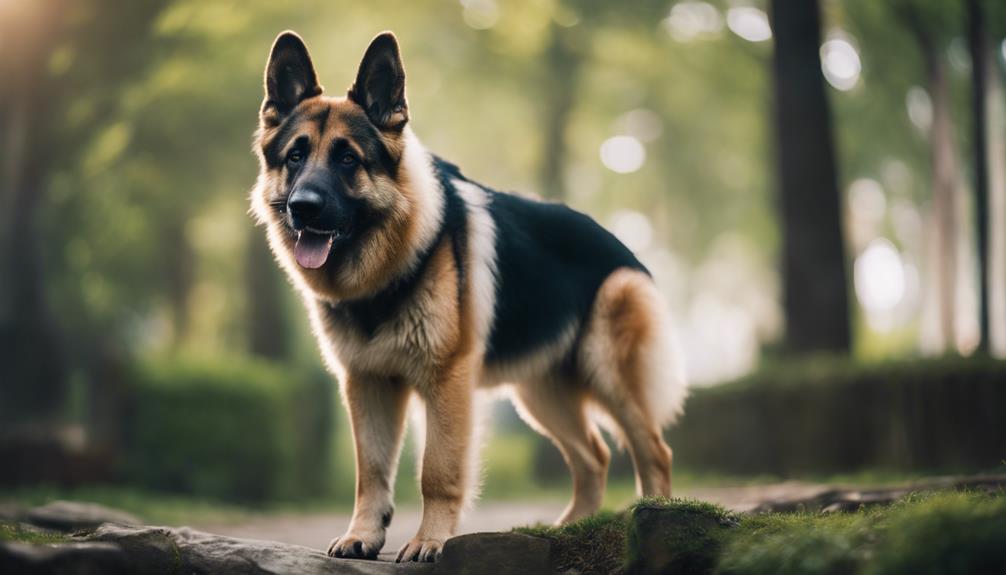
The historical roots and evolution of Panda Shepherds trace back to a genetic anomaly that emerged in purebred German Shepherds around the year 2000. This unique color variation, characterized by approximately 35% white fur intermingled with black and tan, quickly gained attention due to its rarity. Genetic testing has since confirmed the presence of the unusual gene mutation responsible for the panda patterning in German Shepherds.
Breed's Historical Roots
Originating from a genetic anomaly in purebred German Shepherds, the Panda German Shepherd breed boasts a distinctive panda patterning that sets them apart from their traditional counterparts. This rare breed's history is a fascinating tale of genetic mutation and unique markings.
- Panda German Shepherds have a panda patterning of 35% white and the rest black and tan.
- The gene mutation creating Panda Shepherds emerged in 2000, leading to their scarcity and distinct appearance.
- Frankie, the first Panda German Shepherd, was born to purebred parents and underwent genetic testing for confirmation.
- These dogs are not officially recognized by the AKC, adding to their allure and non-standard status within the German Shepherd breed.
Evolution of Panda Shepherds
Through a spontaneous genetic mutation, the distinctive panda patterning of the Panda German Shepherds emerged, setting them apart from their traditional counterparts. This unique coloring comprises approximately 35% white fur, with the remaining coat displaying black and tan shades. Originating from a specific gene mutation in 2000, Panda Shepherds are considered a scarce breed, making them a rare find for enthusiasts. The first Panda German Shepherd, Frankie, descended from two purebred German Shepherd parents, highlighting the controlled nature of the genetic trait. Genetic testing has confirmed the presence of this mutation responsible for the breed's distinct appearance, solidifying the origin and history of Panda Shepherds within the realm of canine genetics.
Modern Phenomenon and Rarity
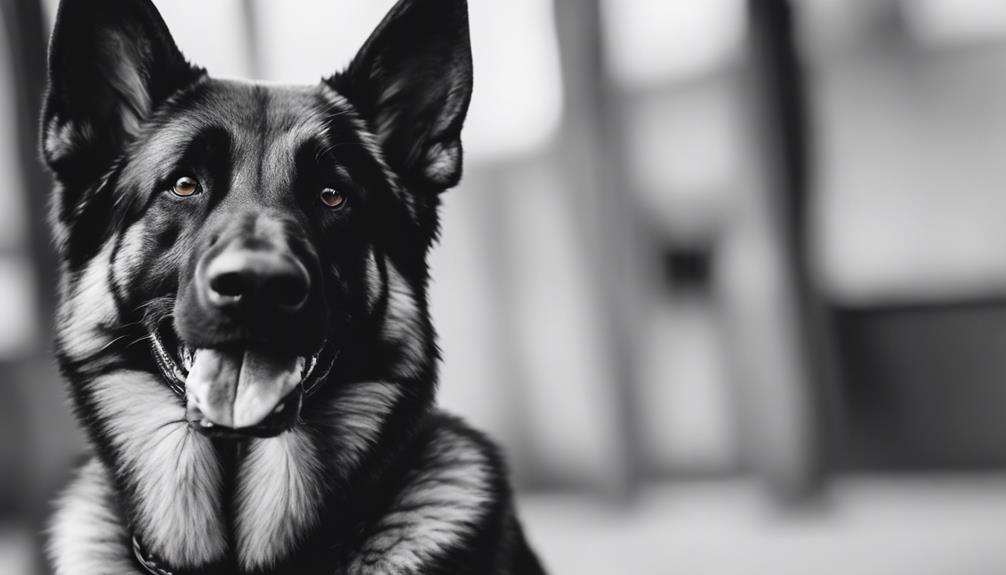
A remarkable genetic mutation in 2000 gave rise to the modern rarity known as the Panda German Shepherd breed. These dogs exhibit a unique color variation with distinctive panda-like markings, consisting of 35% white fur alongside black and tan patches. Panda German Shepherds are considered a scarce breed due to the specific genetic anomaly required for their striking appearance. The first documented Panda German Shepherd, Frankie, had purebred German Shepherd parents, highlighting the unexpected nature of this genetic variation.
- The Panda German Shepherd breed is a product of a genetic mutation in 2000.
- Panda Shepherds display a unique coloration, with 35% white markings and black and tan patches.
- The scarcity of Panda German Shepherds is attributed to the specific genetic anomaly necessary for their appearance.
- Genetic testing can confirm the presence of the mutation responsible for the panda patterning in these dogs.
Through genetic testing, researchers have been able to trace the origins of the panda patterning back to this initial mutation. As a modern rarity, Panda German Shepherds continue to captivate dog enthusiasts with their distinct appearance and unique genetic makeup.
Gender Differences in Panda Shepherds
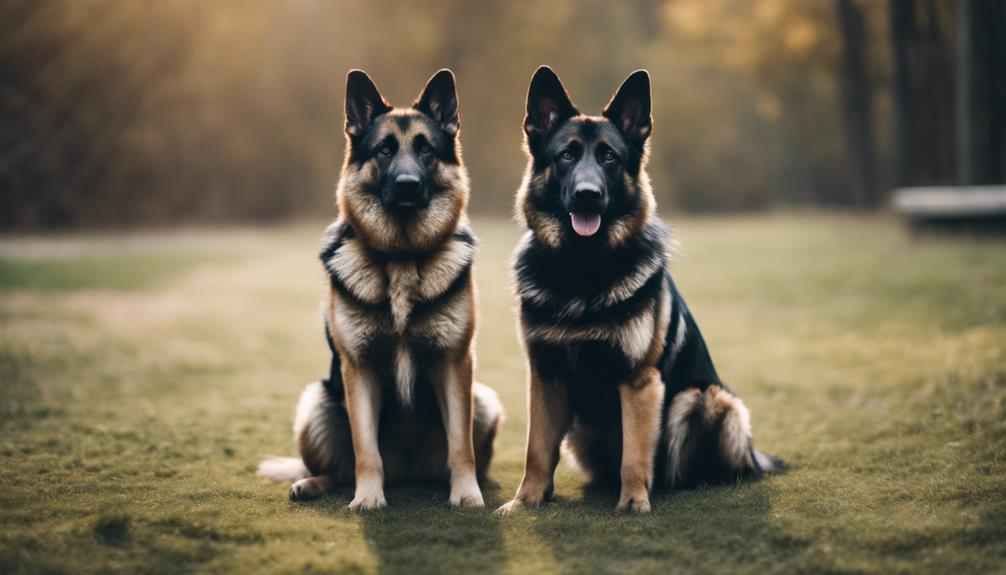
Male and female Panda German Shepherds exhibit distinct physical characteristics, with males generally being larger and heavier than females. These size and weight differences can influence certain behavior patterns and may impact training methods. Understanding these gender disparities can assist in tailoring training techniques and expectations based on the specific traits of male and female Panda Shepherds.
Male Vs Female Traits
In the realm of Panda German Shepherds, discerning gender differences in traits can be crucial for tailored training and understanding individual needs. When considering male vs. female traits in these unique dogs, here are some key points to keep in mind:
- Male Traits:
- More dominance and assertiveness.
- May require firmer leadership.
- Female Traits:
- Display more nurturing and protective tendencies.
- Easier to train due to attentiveness and eagerness to please.
Understanding these nuances can greatly impact the effectiveness of training methods and ensure a harmonious relationship with your male or female Panda Shepherd.
Behavior Patterns by Gender
Behavior patterns by gender in Panda Shepherds reveal distinct differences that impact training and understanding individual needs. While both male and female Panda German Shepherds share the breed's loyal, intelligent, and protective traits, males typically exhibit more dominance and independence. Females, on the other hand, tend to be more nurturing and affectionate. Understanding these gender differences is crucial for effective training and socialization. Males may require firmer handling and consistent boundaries, while females might respond better to positive reinforcement and encouragement. By recognizing these behavior patterns, you can tailor your approach to meet the specific needs of male and female Panda Shepherds, ensuring a well-adjusted and obedient companion.
Training Differences by Sex
Training differences in Panda Shepherds based on sex can influence the approach needed for effective behavior shaping and socialization. When it comes to male and female Panda German Shepherds, here are some key points to consider:
- Tailoring training programs to meet individual needs is crucial, rather than focusing solely on gender.
- Both male and female Panda German Shepherds benefit from behavioral training and socialization efforts.
- Providing consistent leadership is essential for shaping behavior in Panda Shepherds of all genders.
- Gender differences may impact training efforts, requiring a personalized approach to address unique characteristics in male and female Panda German Shepherds.
Panda Shepherd Temperament and Behavior

To understand the temperament and behavior of Panda German Shepherds, one must acknowledge their inherent loyalty, intelligence, and protective instincts, which are characteristic of the standard German Shepherd breed. Panda Shepherds exhibit unwavering loyalty towards their families, making them reliable companions. Their high intelligence allows them to excel in various training activities, but early socialization and training are crucial to ensure they develop well-behaved behaviors. Proper leadership and consistent training help manage their protective nature effectively, as they can become wary of strangers if not properly socialized. With the right guidance, Panda Shepherds make excellent family dogs, particularly around children, due to their protective instincts and gentle demeanor.
Regular exercise is essential for Panda German Shepherds to maintain their physical health and mental well-being. Without adequate exercise and mental stimulation, they may become bored and exhibit destructive behaviors. Engaging them in activities that challenge their intelligence and physical abilities will help prevent behavioral issues. Additionally, a well-exercised Panda Shepherd is more likely to exhibit calm and balanced behavior at home.
Panda Shepherd Health and Care
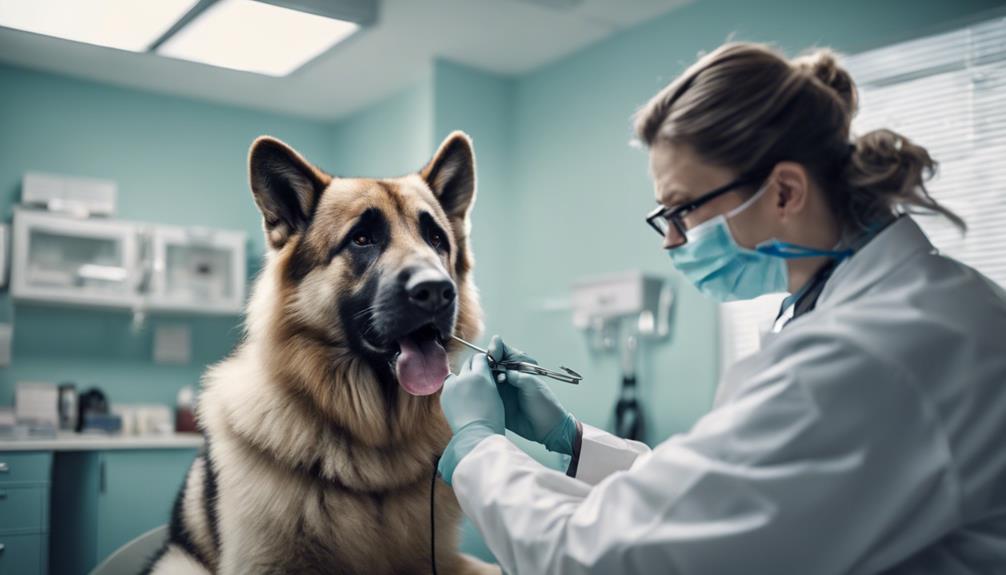
Regular veterinary check-ups play a crucial role in monitoring the unique health concerns of Panda German Shepherds due to their genetic makeup. Being aware of potential health issues is vital for proactive management in Panda German Shepherds. Here are some key points to consider for the health and care of Panda German Shepherds:
- Proper care and a healthy environment contribute to the longevity of Panda German Shepherds, who have an average lifespan of 12-14 years.
- Timely vet check-ups aid in early detection of health issues, contributing to a long and healthy life for Panda German Shepherds.
- Routine care, including regular grooming and health monitoring, is essential for the overall health of Panda German Shepherds.
- Health testing for genetic health concerns specific to the Panda German Shepherd breed is recommended to identify and address any potential issues early on.
Finding a Panda Shepherd Breeder

When seeking a Panda Shepherd breeder, prioritize finding specialists in the breeding of this unique color variation of the German Shepherd breed. Look for breeders who have experience specifically with Panda German Shepherds to ensure they understand the intricacies of this rare color variation. It is crucial to check if the breeder conducts health testing and genetic screening in their breeding program. This ensures that the Panda Shepherd puppies are healthy and free from common genetic issues.
Visiting the breeder in person is essential to assess the living conditions and the care provided to the dogs. Meeting the parents of the Panda German Shepherd puppies allows you to gauge their temperament and overall health, which can give you valuable insight into the potential traits of the puppies. Additionally, evaluating the breeder's reputation and reviews is vital. A good breeder should have a solid track record and positive feedback from previous customers, indicating their commitment to responsible breeding practices.
Finding a reputable Panda Shepherd breeder who meets these criteria is essential in ensuring that you bring home a healthy and well-adjusted puppy of this rare color variation.
Is the Panda German Shepherd Right for You?

If considering adding a Panda German Shepherd to your family, it is important to understand the unique characteristics and care requirements of this breed. Here are some key points to consider:
- Temperament: Panda German Shepherds are known for their loyalty, intelligence, and protectiveness, making them great family dogs.
- Training: Proper socialization and training from an early age are vital for managing the temperament of Panda German Shepherds.
- Exercise: Regular exercise and mental stimulation are crucial for the happiness and health of Panda German Shepherds.
- Leadership: These dogs require consistent leadership and training to prevent behavior issues and ensure their well-being.
The Panda German Shepherd's loyalty and intelligence make them wonderful companions for those willing to invest time in their training and exercise needs. However, it is essential to provide them with the necessary socialization, leadership, and mental stimulation to thrive. If you are dedicated to meeting these requirements and providing a loving environment, a Panda German Shepherd could be the right fit for you. Remember, their well-being and happiness depend on your commitment to their care.
Frequently Asked Questions
What Is a Panda German Shepherd Breed?
A Panda German Shepherd breed is known for its unique panda-like markings, resulting from a genetic mutation. These dogs exhibit loyal, intelligent, and protective temperaments. Grooming, training, socialization, exercise, diet, and health concerns are important aspects to consider.
How Much Are Panda German Shepherds Worth?
Panda German Shepherds typically range from $1500 to $3000, but some can go up to $5000 due to rarity. Factors like lineage, breeder reputation, and demand influence prices. Adoption fees vary as well.
What Is the Difference Between a Piebald and a Panda German Shepherd?
When distinguishing between a piebald and a Panda German Shepherd, focus on their coat variations. Piebalds feature large white patches, while Pandas have unique black, tan, and white markings resembling panda bear spots, stemming from a specific genetic mutation.
Do Panda Shepherds Have Blue Eyes?
Yes, Panda German Shepherds can have blue eyes. These unique eye colors are a result of genetic mutations that also give them their distinctive coat patterns. Blue-eyed Pandas stand out for their captivating appearance and are sought after for their striking look.
Conclusion
In conclusion, owning a Panda German Shepherd can be a unique and rewarding experience. Their striking appearance and loyal nature make them a beloved companion for those willing to put in the time and effort to care for them properly. Remember, just like any other breed, Panda Shepherds require love, attention, and proper training to thrive. So, embrace the panda magic and watch your furry friend blossom like a rare flower in your home garden.
